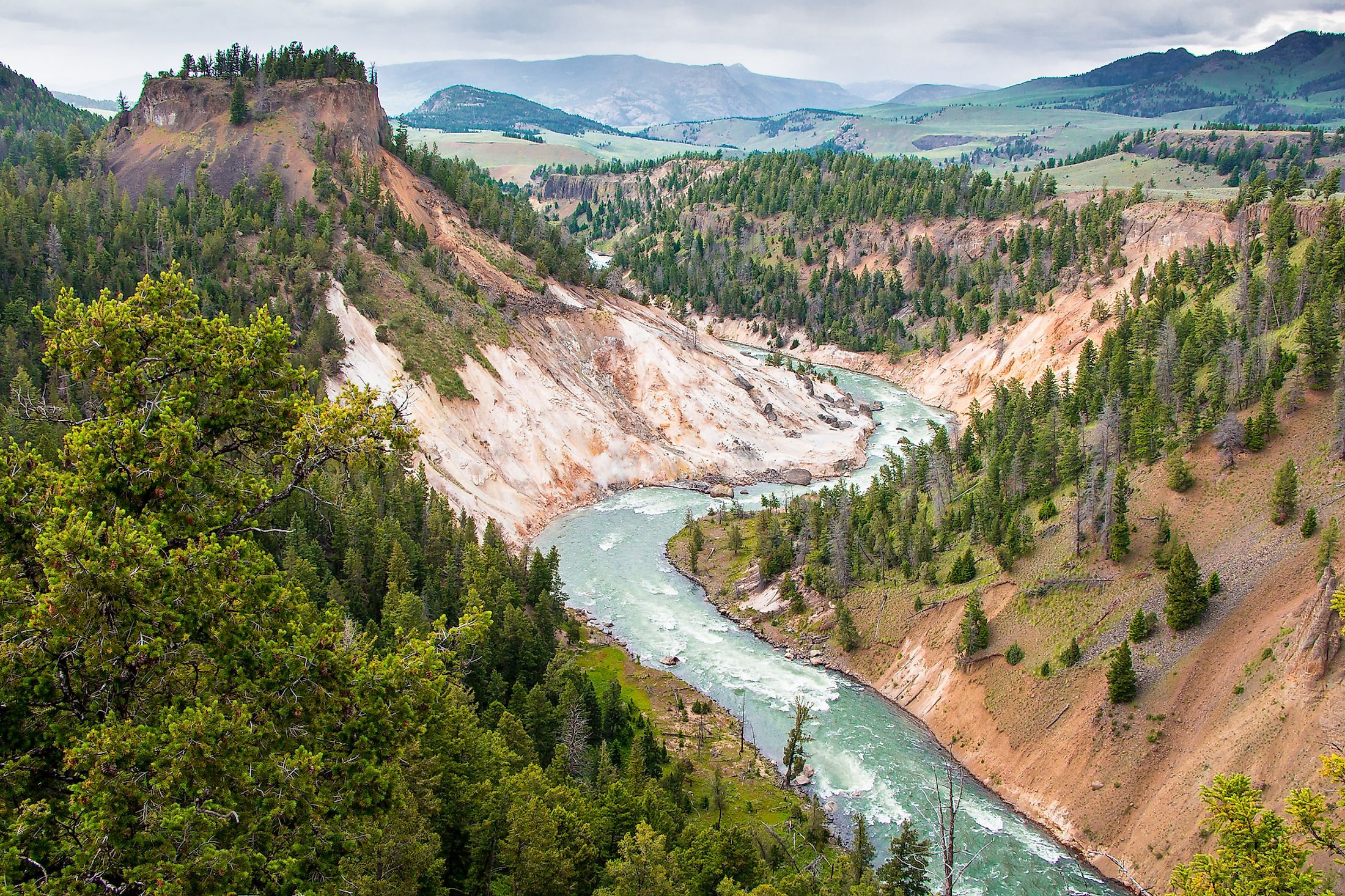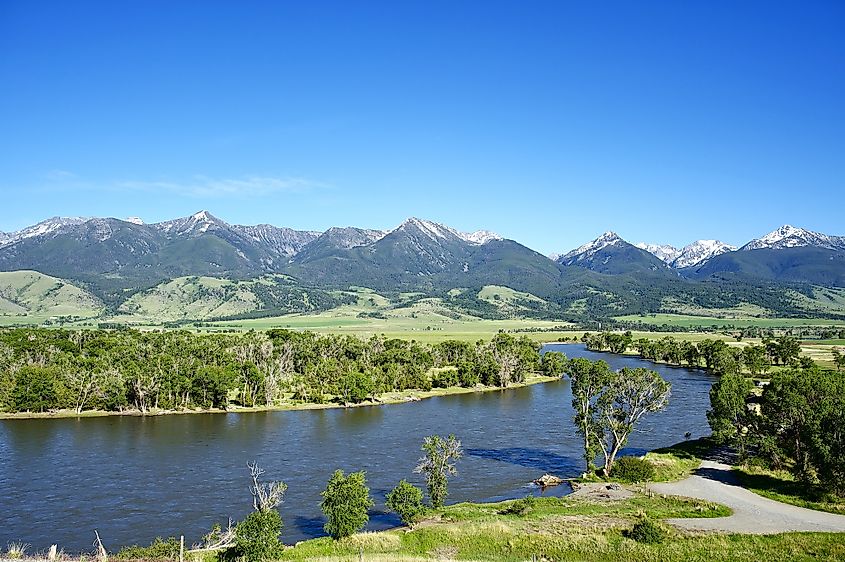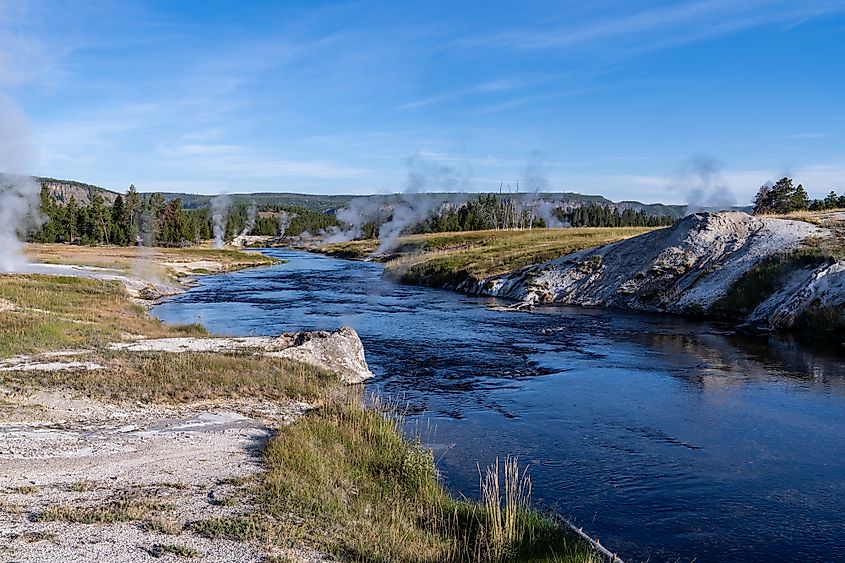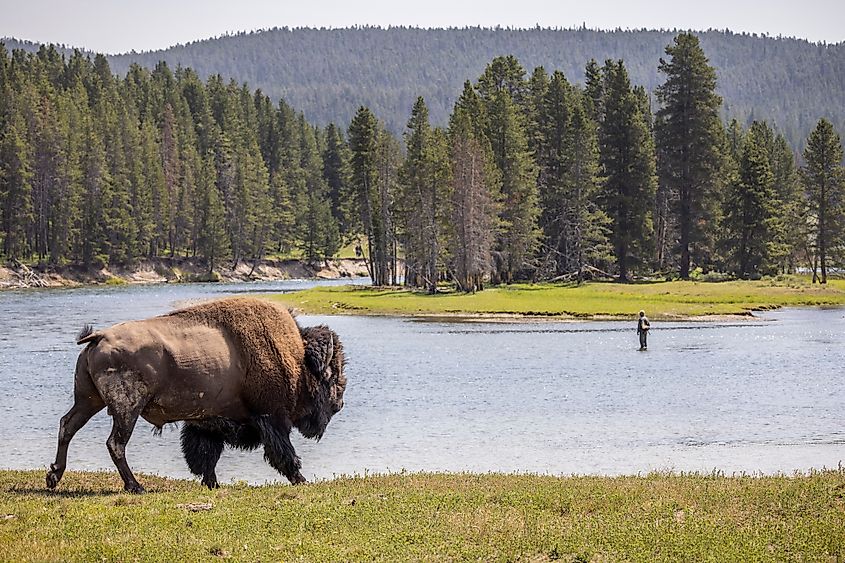
Yellowstone River
Noted for its scenic beauty, the Yellowstone River flows a course of 692 miles through the US states of Wyoming, Montana, and North Dakota. Although containing sections with an overall calm flow, the river can turn rough as dramatic crashing waterfalls also occur over its course. Despite persistent threats, the river continues to be the longest and only undammed river in the lower 48 states and upper Missouri’s principal tributary.
Geography And Flow Of The Yellowstone River
Beginning in Wyoming’s Absaroka Range on the slopes of Yount Peak, the Yellowstone River drains approximately 70,000 square miles of land before joining the Missouri River northeast of Sidney, Montana. As such, the 692-mile-long river flows through northwestern Wyoming, southeastern Montana, and northwestern North Dakota. After rising in Yount Peak, the river enters Yellowstone National Park’s southeastern corner before flowing northward into Yellowstone Lake. As it leaves Yellowstone Lake, the river cascades into two waterfalls. The Upper Falls plunge at the height of 109 feet, whereas the Lower Falls plunge a total of 308 feet into Yellowstone’s Grand Canyon. As it leaves the Canyon, the river plunges into a third 132-foot waterfall named Tower Falls.

The Yellowstone River then leaves the Yellowstone National Park at Gardiner, Montana. Upon reaching Miner, the river flows northeastward into Livingston. After flowing past Miles City and Glendive, the river crosses from Montana into North Dakota northeast of Sidney. The river concludes its course as it joins the Missouri River just southwest of Williston. Given the absence of any dams, the Yellowstone River is the last and longest free-flowing river in the lower 48 US states. In terms of its principal tributaries, all of them find their origins in the Bighorn Mountains and the Absaroka and Wind River ranges. These tributaries are the Tongue, Powder, and Bighorn rivers.
Brief History Of The Yellowstone River
Before people of European ancestry explored the area in 1806, the Yellowstone River was initially used by the Native Americans as a water source for irrigation and a mode of transport. In fact, the river was known by the completely different name of “Elk River” at the time. After the Lewis and Clark expedition made its way back from the Pacific Northwest, Lieutenant William Clark launched an effort to sail through and explore the river. The river was further explored using bull boats, hollowed-out logs, and pirogues by the likes of Jim Bridger, Jed Smith, and John Colter. In 1807, Colter, renowned as a trapper and as the first person of European descent to explore the Yellowstone region, formed a partnership with fur trader Manuel Lisa and established the river’s first trading post. During the 1860s and 1870s, the region surrounding the river experienced extensive periods of conflict between the US government and the Native Americans inhabiting the area. By the early 1880s, settlement in the area began to increase as a direct result of the Northern Pacific Railway, which subsequently led to the river’s extensive use for irrigation.

Yet, perhaps the single event most notable when considering the Yellowstone River’s current status is thwarting the massive dam proposal in the 1970s. This proposal, which aimed to flood Paradise Valley through a dam in Allenspur Canyon, was successfully thwarted after conservationists joined together and fought against its construction, which would have substantially modified the region’s entire ecology, landscape, and economy. Nevertheless, the river continues to face notable threats in the form of unwise floodplain development and widespread channelization projects, which eliminate essential side-channel habitat and floodplain access. As such, the Yellowstone River has been repeatedly placed on America’s Most Endangered Rivers list in 1995, 1999, and 2006. In 2011, the US Army Corps of Engineers responded to these threats through the creation of a Special Area Management Plan aimed at limiting the development of future channelization projects.
Ecological Diversity Of The Yellowstone River

Today, the Yellowstone River continues to flow in its natural state after victoriously remaining undammed. As a result, the river maintains high ecological diversity and hosts a plethora of local species. Some species that frequently inhabit the Yellowstone River corridor are bald eagles, cougars, whitetail deer, pronghorn antelope, bison, black bears, and grizzly bears. Rare sightings of North American River Otters have also been reported within the river, as Yellowstone’s unique geography creates a suitable environment for the species. The river’s native fish species, including Arctic grayling, cutthroat trout, mountain whitefish, Utah chub, longnose dace, and mottled sculpin, underpin the region’s natural food webs.
However, several nonnative species introduced to the area have consistently posed threats to these endemic populations. As the Yellowstone National Park’s waters were most fishless upon its establishment, they were restocked with both native and nonnative fish species. Among the river’s nonnative species are brown trout, brook trout, lake chub, lake trout, and rainbow trout. This, in turn, changed much of the river’s ecology, as such stocking enabled nonnative fish to outcompete and hybridize with endemic species. To recover from the poor native trout populations of the 1960s, regulations were placed in the 1980s to restrict fish harvest. Fishing regulations were further updated in 2001 to require the release of any native species that are caught from the river. Furthermore, a 2010 Native Fish Conservation Plan/Assessment was completed to reduce the native fish populations’ extinction risk and maintain the pivotal ecosystems that this river upholds.











